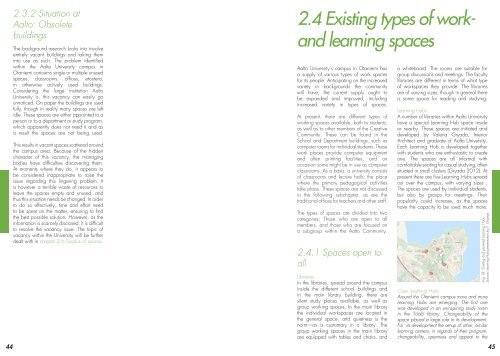View/Open - Aaltodoc
View/Open - Aaltodoc
View/Open - Aaltodoc
You also want an ePaper? Increase the reach of your titles
YUMPU automatically turns print PDFs into web optimized ePapers that Google loves.
44<br />
2.3.2 Situation at<br />
Aalto: Obsolete<br />
buildings<br />
The background research looks into involve<br />
entirely vacant buildings and taking them<br />
into use as such. The problem identified<br />
within the Aalto University campus in<br />
Otaniemi concerns single or multiple unused<br />
spaces, classrooms, offices, etcetera,<br />
in otherwise actively used buildings.<br />
Considering the large institution Aalto<br />
University is, this vacancy can easily go<br />
unnoticed. On paper the buildings are used<br />
fully, though in reality many spaces are left<br />
idle. These spaces are either appointed to a<br />
person or to a department or study program,<br />
which apparently does not need it and as<br />
a result the spaces are not being used.<br />
This results in vacant spaces scattered around<br />
the campus area. Because of the hidden<br />
character of this vacancy, the managing<br />
bodies have difficulties discovering them.<br />
At moments where they do, it appears to<br />
be considered inappropriate to raise the<br />
issue regarding this lingering problem. It<br />
is however a terrible waste of resources to<br />
leave the spaces empty and unused, and<br />
thus this situation needs be changed. In order<br />
to do so effectively, time and effort need<br />
to be spent on the matter, ensuring to find<br />
the best possible solution. However, as the<br />
information is scarcely disclosed, it is difficult<br />
to resolve the vacancy issue. The topic of<br />
vacancy within the University will be further<br />
dealt with in chapter 2.6 Surplus of spaces.<br />
2.4 Existing types of work-<br />
and learning spaces<br />
Aalto University’s campus in Otaniemi has<br />
a supply of various types of work spaces<br />
for its people. Anticipating on the increased<br />
variety in backgrounds the community<br />
will have, the current supply ought to<br />
be expanded and improved, including<br />
increased variety in types of spaces.<br />
At present, there are different types of<br />
working spaces available, both to students,<br />
as well as to other members of the Creative<br />
Community. These can be found in the<br />
School and Department buildings, such as<br />
computer rooms for individual students. These<br />
work places provide computer equipment<br />
and often printing facilities, and on<br />
occasion some might be in use as computer<br />
classrooms. As a basis, a university consists<br />
of classrooms and lecture halls: the place<br />
where the primary pedagogical activities<br />
take place. These spaces are not discussed<br />
in the following subchapter, as are the<br />
traditional offices for teachers and other staff.<br />
The types of spaces are divided into two<br />
categories: Those who are open to all<br />
members, and those who are focused on<br />
a subgroup within the Aalto Community.<br />
2.4.1 Spaces open to<br />
all<br />
Libraries<br />
In the libraries, spread around the campus<br />
inside the different school buildings and<br />
in the main library building, there are<br />
silent study places available, as well as<br />
group working spaces. In the main library<br />
the individual workspaces are located in<br />
the general space, and quietness is the<br />
norm—as is customary in a library. The<br />
group working spaces in the main library<br />
are equipped with tables and chairs, and<br />
a whiteboard. The rooms are suitable for<br />
group discussions and meetings. The faculty<br />
libraries are different in terms of what type<br />
of workspaces they provide. The libraries<br />
are of varying sizes, though in general there<br />
is some space for reading and studying.<br />
Learning Hubs<br />
A number of libraries within Aalto University<br />
have a special Learning Hub space inside<br />
or nearby. These spaces are initiated and<br />
developed by Valeria Gryada, Interior<br />
Architect and graduate of Aalto University.<br />
Each Learning Hub is developed together<br />
with students who are enthusiastic to create<br />
one. The spaces are all informal with<br />
comfortable seating for casual studying, often<br />
situated in small clusters (Gryada 2012). At<br />
present there are five Learning Hubs spread<br />
out over the campus, with varying sizes .<br />
The spaces are used by individual students,<br />
but also by groups for meetings. Their<br />
popularity could increase, as the spaces<br />
have the capacity to be used much more.<br />
Img 18: Existing and planned Learning Hubs<br />
Source: Learning Hub presentation by V. Gryada<br />
Case Learning Hubs<br />
Around the Otaniemi campus more and more<br />
Learning Hubs are emerging. The first one<br />
was developed in an uninspiring study room<br />
in the Töölö library. Changeability of the<br />
space played a large role in its development.<br />
For its development the set-up of other, similar<br />
learning centers, in regards of their program,<br />
changeability, openness and appeal to the<br />
45
















